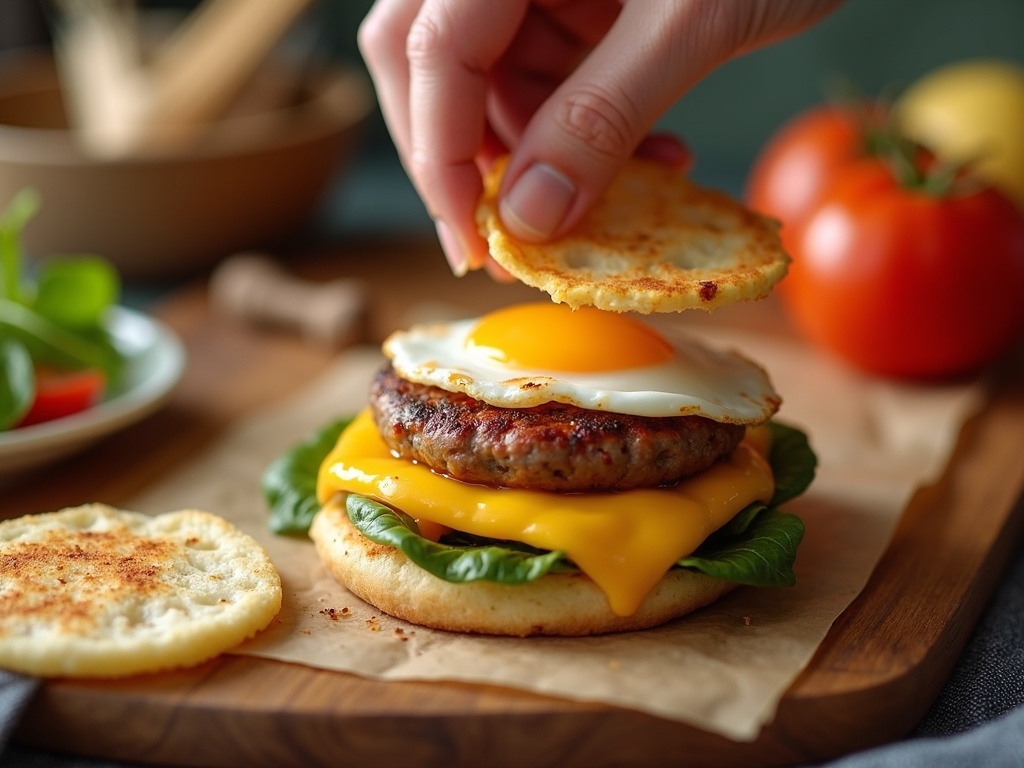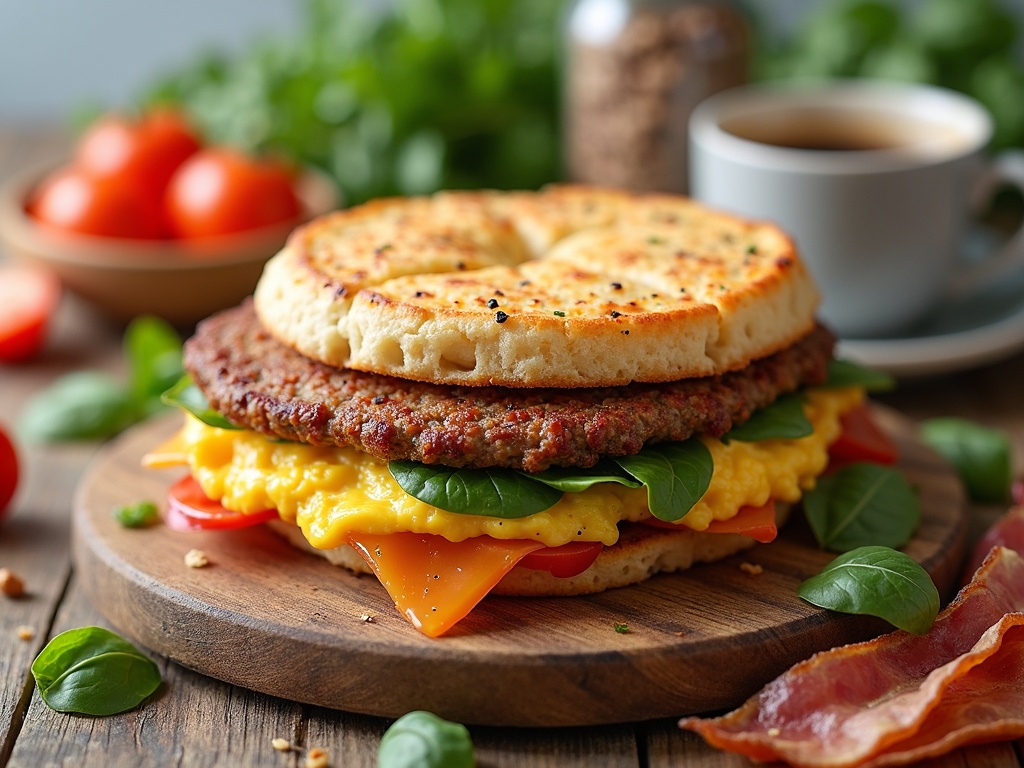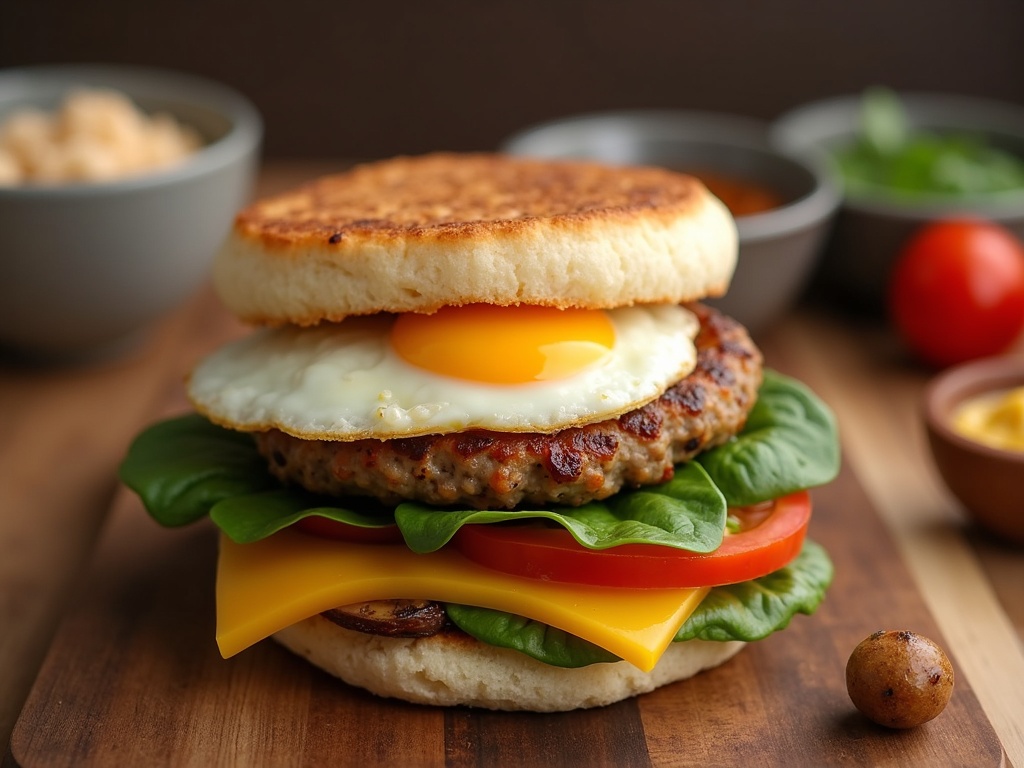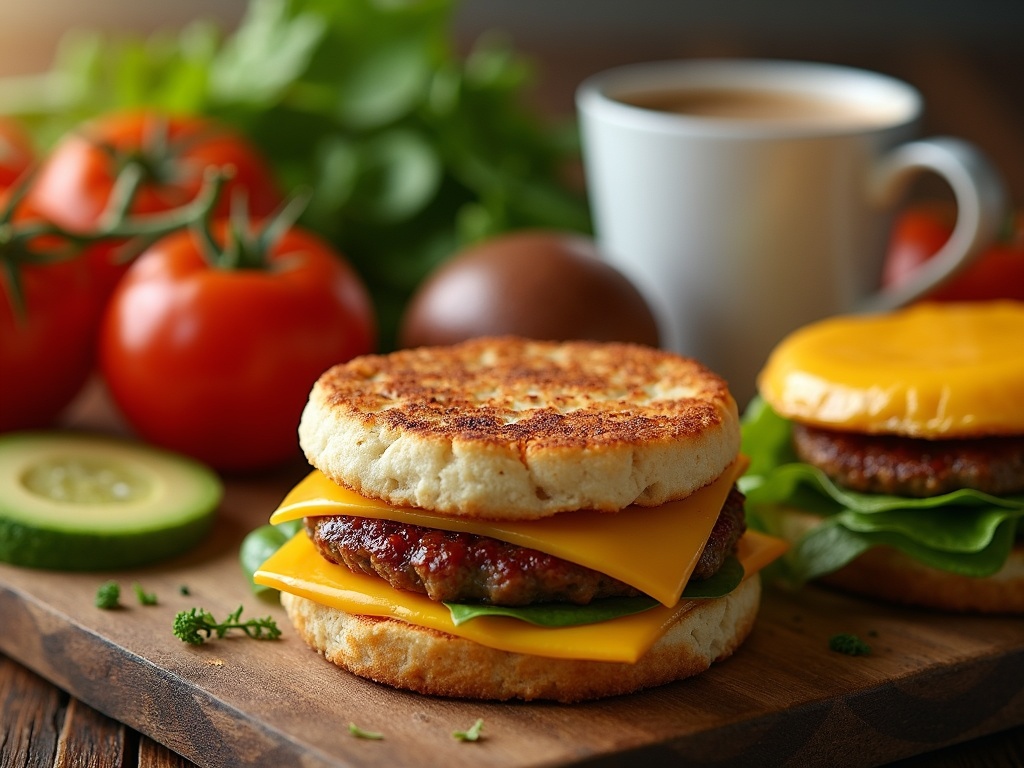The Sausage McMuffin, introduced by McDonald’s in 1971, transformed American breakfast habits by creating a handy, portable morning meal that still sells about 2 million units daily worldwide. This classic combination of English muffin, flavorful sausage patty, and American cheese provides 300 calories and 12g of protein while establishing the fast-food breakfast category that has shaped eating habits for generations.
Find In This Article
Key Takeaways
- The Sausage McMuffin was McDonald’s first breakfast sandwich ever, transforming morning eating habits and creating an entirely new category of on-the-go breakfast options.
- With 300 calories, 12g of protein, and 20g of fat, the sandwich provides a balanced nutritional profile that delivers both satisfaction and energy.
- Making homemade versions allows for customization with healthier alternatives like turkey sausage, whole grain English muffins, or added vegetables.
- The classic sandwich can be enhanced with creative variations including spicy additions, plant-based alternatives, or gourmet ingredients like specialty cheeses.
- Proper assembly techniques and ingredient order are crucial for recreating the authentic taste and texture of this breakfast staple.
The Ultimate Fast-Food Breakfast Success Story
When McDonald’s unveiled the Sausage McMuffin in 1971, they weren’t just launching another menu item – they were revolutionizing morning eating habits across America. This iconic breakfast sandwich started a culinary movement that continues to thrive decades later.
From Innovation to Institution
The Sausage McMuffin wasn’t just McDonald’s first McMuffin offering – it was their first breakfast sandwich ever. What began as an experiment has transformed into a morning ritual for millions. Today, approximately 2 million of these handheld breakfast delights are sold daily worldwide, making it one of the most successful items in fast-food history.
I’ve watched this simple combination of English muffin, savory halal sausage patty, and American cheese become a cultural touchstone. Its straightforward preparation and satisfying taste profile helped establish McDonald’s breakfast as a legitimate dining option when on-the-go morning meals weren’t yet mainstream.
The numbers tell an impressive story: each Sausage McMuffin contains 300 calories, packs 12g of protein, and includes 20g of fat. This nutritional profile delivers both satisfaction and enough energy to kick-start your day. For many busy professionals, parents, and students, it represents the perfect balance of convenience, taste, and fuel.
Cultural Impact and Market Domination
The Sausage McMuffin didn’t just change McDonald’s – it transformed American eating habits. According to consumer studies, 43% of Americans now regularly enjoy breakfast sandwiches as part of their morning routine. This represents a massive shift from traditional sit-down breakfast norms of previous generations.
This iconic sandwich marked the true beginning of the fast-food breakfast era. Before its introduction, breakfast was largely considered a home-based meal or reserved for diners and cafes. The portability and convenience of the Sausage McMuffin created an entirely new category of morning dining.
Its influence extends beyond just McDonald’s success. The sandwich’s popularity sparked waves of competition across the fast-food industry, with virtually every major chain developing their own breakfast sandwich offerings. Yet through decades of competition, the original continues to thrive.
I’ve noticed how the Sausage McMuffin maintains relevance even as food trends come and go. Its staying power comes from several key factors:
- Consistency in preparation and taste across thousands of locations
- Affordable price point compared to coffee shop alternatives
- Recognizable, straightforward ingredients that appeal to multiple generations
- Portable format that fits modern on-the-go lifestyles
- Availability during McDonald’s all-day breakfast service at many locations
The McDonald’s breakfast menu has expanded dramatically since 1971, but the Sausage McMuffin remains a cornerstone offering. Its success story illustrates how a well-executed simple concept can transform not just a company but an entire category of dining.
What started as an experiment has become an essential part of American food culture. The Sausage McMuffin’s journey from novelty to necessity exemplifies how fast food innovations can transcend their origins to become culinary institutions.
Create Your Perfect Sausage McMuffin at Home
Making a homemade version of the iconic Sausage McMuffin is easier than you might think. I’ve mastered this recipe through plenty of trial and error, and I’m excited to share my approach for recreating this beloved breakfast sandwich right in your kitchen.
The Essential Components
First, let’s gather all the necessary ingredients for your homemade Sausage McMuffin:
- English muffins (preferably plain variety)
- Breakfast sausage patties (pre-formed or shape your own)
- American cheese slices
- Large eggs
- Butter for toasting (optional)
- Cooking spray for the egg rings
- Hot sauce (optional for extra flavor)
The beauty of making this classic McDonald’s breakfast item at home is that you can control the quality of ingredients while still achieving that familiar taste and texture.
Step-by-Step Assembly Process
I start by toasting the English muffin halves until they’re golden brown. This can be done in a toaster, but for a more authentic result, I lightly butter the cut sides and toast them face-down in a skillet. This creates that perfect crispy exterior while maintaining a soft interior.
For the sausage patty, cook it on medium heat for about 4-6 minutes per side. The goal is to get a nice brown crust on both sides while ensuring it’s cooked all the way through. If you’re making your own patties, I recommend using ground pork with some sage, thyme, and a touch of maple syrup for that classic breakfast sausage flavor.
The egg requires some attention to detail. For that signature round shape that makes a McMuffin recognizable, use a circular mold in your pan. Egg rings are perfect, but in a pinch, I’ve used cleaned tuna cans with both ends removed. Spray the inside of your mold with cooking spray, place it in a hot pan, and crack an egg inside. Add a tablespoon of water to the pan and cover to help the egg cook evenly.
Now comes the assembly – the foundation of a perfect sandwich. Layer your ingredients in this order:
- Bottom half of toasted English muffin
- Cooked sausage patty
- American cheese slice
- Perfectly cooked round egg
- Top half of toasted English muffin
The heat from the freshly cooked components will naturally melt the cheese, creating that gooey texture that’s essential to the McDonald’s all-day breakfast experience.
Timing is crucial – I serve these immediately while everything is still hot. The contrast between the crispy muffin, savory sausage, melted cheese, and tender egg creates that perfect bite that makes this sandwich so popular.
What I love about making these at home is the ability to customize. Want a spicier version? Add hot sauce or pepper jack cheese instead of American. Prefer a healthier option? Use whole grain English muffins and turkey sausage.
This homemade version gives you all the satisfaction of the drive-thru favorite but with the pride of having made it yourself. Plus, you can enjoy your creation without leaving the house – perfect for lazy weekend mornings when you’re craving that familiar taste of a classic fast-food breakfast.
Common Mistakes to Avoid
When making your own homemade version of the popular McMuffin, small errors can make a big difference in the final result. I’ve made these mistakes myself and learned some valuable lessons along the way.
Cooking Technique Errors
Overcooking the sausage patty is perhaps the most common mistake I see people make. When sausage is cooked too long, it becomes dry and tough, losing that juicy texture that makes a breakfast sandwich so satisfying. The key is to cook the patty just until it reaches an internal temperature of 160°F – any longer and you’ll sacrifice moisture and flavor.
Skipping the English muffin toasting step is another error that significantly impacts the final product. An untoasted muffin not only has a bland taste but also tends to become soggy when it comes in contact with the hot ingredients. I always toast my muffins to a light golden brown, which creates a slight crunch and enhances the nutty flavor that complements the savory elements of the McDonald’s breakfast sandwich.
Improper egg preparation can lead to a soggy sandwich that falls apart after the first bite. Common egg mistakes include:
- Using too much butter or oil when cooking
- Not cooking the egg thoroughly enough
- Breaking the yolk too early if aiming for a classic McMuffin style
- Failing to properly shape the egg to fit the muffin size
The assembly order matters more than you might think. When I first started making these sandwiches at home, I didn’t pay attention to how I was layering the ingredients. This affected both how the cheese melted and the overall texture experience. The optimal order follows the McDonald’s breakfast formula: bottom muffin half, cheese slice, sausage patty, egg, and finally the top muffin half.
Customization Mishaps
Not considering personal preferences and possible modifications is a mistake that limits your enjoyment. Many people try to replicate the exact McDonald’s all-day breakfast experience without thinking about what they personally enjoy.
I find that customizing your homemade version allows for a better eating experience tailored to your tastes. Consider these possible modifications:
- Switching to turkey sausage for a leaner option
- Adding fresh vegetables like spinach or tomato for extra nutrients
- Experimenting with different cheese varieties beyond American
- Adjusting cooking time for the egg based on your preference for runny or firm yolks
- Trying different spice blends in your sausage patty
Another common misstep is neglecting temperature management during assembly. If your muffin is too cool when you add the cheese, it won’t melt properly. Similarly, if you let the sausage patty sit too long before adding it to your breakfast sandwich, it might cool down and affect the overall warmth of your meal.
By avoiding these common pitfalls, you’ll be well on your way to creating a delicious homemade version that might even surpass the original fast-food favorite. The key is attention to detail and understanding how each component contributes to the overall taste and texture experience.

Creative Variations and Alternatives
I’ve discovered that one of the beauties of a McMuffin is its versatility. The classic version serves as a perfect canvas for customization, allowing you to create exciting variations that match your taste preferences and dietary needs.
Plant-Based and Spicy Alternatives
For those following a vegetarian diet, I’ve found that substituting traditional sausage with plant-based alternatives creates an equally satisfying experience. Modern plant-based patties mimic the texture and flavor of meat remarkably well, providing that familiar savory component without animal products. I like to add a slice of tomato and some spinach to enhance the freshness of this version.
Looking to add some heat to your morning routine? Try these spicy modifications:
- Add thinly sliced jalapeños between the egg and cheese
- Drizzle hot sauce on the patty before assembly
- Mix sriracha with mayonnaise for a spicy spread
- Incorporate pepper jack cheese instead of American
These additions transform the standard McDonald’s breakfast into something with a fiery kick that wakes up your taste buds alongside your morning coffee.
Gourmet and Indulgent Upgrades
I’ve elevated the humble breakfast sandwich into something truly special by incorporating premium ingredients. Sliced avocado adds creamy richness and healthy fats, while specialty cheeses like aged cheddar, goat cheese, or smoked gouda introduce complex flavor profiles that complement the savory sausage perfectly.
For the ultimate indulgent version, I add crispy bacon strips on top of the sausage patty. This meat lover’s dream delivers a combination of textures and flavors that makes an already satisfying McD breakfast even more impressive. The saltiness of the bacon enhances the overall flavor profile and adds that irresistible crunch.
When I’m in the mood for something different but still want those classic flavors, I transform the ingredients into a breakfast burrito. I simply scramble the egg, chop the sausage patty, add cheese, and wrap everything in a warm tortilla. This handheld alternative makes for easier eating on busy mornings and opens up possibilities for additional fillings like hash browns, bell peppers, or onions.
Health-conscious eaters aren’t left out of these creative variations. I’ve found several ways to make a lighter version while maintaining flavor:
- Swap traditional sausage for lean turkey sausage
- Replace the English muffin with a whole grain alternative
- Use egg whites instead of whole eggs
- Add extra vegetables for nutrients and fiber
- Choose reduced-fat cheese or use less of a full-fat variety
These modifications significantly reduce calories and fat while boosting the nutritional value of your McDonald’s all day breakfast favorite.
The beauty of homemade versions is the control over ingredients and portions. I’ve noticed that making these variations at home lets me adjust seasoning levels, choose higher quality components, and cater to specific dietary needs that might be difficult to accommodate with the standard restaurant offering.
Each of these creative spins on the classic Sausage McMuffin preserves what makes the original great while introducing new flavor dimensions. Whether you’re looking for a healthier option, craving something spicy, or wanting to impress weekend guests with a gourmet breakfast spread, these variations prove that this iconic sandwich can be reinvented in countless delicious ways.

Make It Your Own
The basic Sausage McMuffin is delightful on its own, but I’ve discovered that personalizing this classic breakfast sandwich can take it to the next level. Whether you’re recreating this McDonald’s favorite at home or customizing your order at the restaurant, there are countless ways to make it uniquely yours.
Flavorful Customizations
I’ve found that swapping the cheese creates an entirely different taste experience. While the standard American cheese offers that classic melt, trying sharp cheddar adds a tangy bite, or pepper jack introduces a welcome spicy kick. The cheese choice alone can transform your McMuffin experience.
Adding vegetables brings freshness and nutrition to your breakfast. I love layering in:
- Baby spinach leaves for iron and vitamins
- Sliced tomato for juiciness and lycopene
- Avocado for healthy fats and creaminess
- Arugula for a peppery contrast
- Sautéed mushrooms for earthy flavor
The egg preparation method significantly impacts the final result. While the traditional round egg is iconic for McDonald’s breakfast items, I sometimes prefer scrambled eggs for a different texture or over-easy for that delicious runny yolk experience.
Condiments and sauces can make or break your custom creation. A spread of hot sauce adds zing, while a touch of maple syrup creates a sweet-savory balance that’s unexpected but delicious. Hollandaise sauce transforms it into a Benedict-inspired treat, and chipotle mayo adds smoky complexity.
For a healthier spin on this McDonald’s breakfast favorite, I often substitute the traditional pork sausage with leaner turkey sausage patties. They still deliver that satisfying savory element with less fat. Plant-based sausage alternatives have come a long way in flavor and texture, making them excellent options for vegetarians or those looking to reduce meat consumption.
The beauty of making your own version of the McMuffin at home is having complete control over ingredients and portions. I can adjust seasoning levels, choose organic components, or create fusion flavors by incorporating international spices and toppings. Some days call for classic simplicity, while others demand creative experimentation – either way, the humble Sausage McMuffin serves as the perfect canvas.

Health and Nutrition Insights
The Sausage McMuffin delivers a substantial 12g of protein per serving, making it a protein-rich choice to kickstart your day. I’ve found that adequate protein consumption in the morning helps maintain steady energy levels throughout the day and supports muscle recovery, especially after morning workouts.
Nutritional Profile and Dietary Modifications
This classic breakfast sandwich offers a balanced combination of macronutrients that can be tailored to various dietary needs. The standard version contains protein from the sausage patty and egg, carbohydrates from the English muffin, and fats from the cheese and meat components.
For those monitoring their intake, several modifications can make this McMuffin more aligned with specific dietary goals:
- Request no cheese to reduce fat and sodium content
- Ask for egg whites instead of whole eggs to lower cholesterol
- Skip the butter on the English muffin to decrease calories
- Request extra vegetables when available for added nutrients
- Choose chicken sausage over beef for a leaner protein option
These simple adjustments don’t drastically change the enjoyable taste but can significantly impact the nutritional profile.
Healthier Homemade Alternatives
Creating your own version of this popular McDonald’s breakfast item at home opens up even more possibilities for nutrition-focused improvements. I’ve experimented with several ingredient substitutions that maintain the satisfying taste while boosting nutritional value:
The standard English muffin can be swapped for whole grain versions that provide more fiber and complex carbohydrates. This simple change helps stabilize blood sugar levels and promotes longer-lasting energy.
For the protein component, turkey or chicken sausage contains less saturated fat than traditional pork sausage while still delivering savory flavor. Plant-based sausage alternatives work well for vegetarians or those reducing meat consumption.
Low-fat cheese or reduced-portion sizes of regular cheese cut calories while maintaining that essential melty texture that makes the McDonald’s breakfast experience so satisfying.
Adding vegetables like spinach, tomato, or avocado introduces beneficial vitamins, minerals, and healthy fats that aren’t found in the original recipe.
The beauty of this breakfast classic lies in its perfect balance of protein, carbs, and fats – the three macronutrients essential for a complete morning meal. This balance helps prevent mid-morning energy crashes often experienced after consuming purely carbohydrate-based breakfasts like pastries or cereals.
Starting your day with protein helps regulate appetite throughout the morning, potentially reducing overall calorie consumption later in the day. The combination of protein and fats provides satiety, while the carbohydrates offer immediate energy for morning activities.
For those who enjoy the convenience of McDonald’s all-day breakfast but are nutrition-conscious, the Sausage McMuffin represents one of the more balanced options on the menu. Paired with a piece of fruit or a side salad, it transforms into a relatively well-rounded meal that delivers both satisfaction and sustenance.
Sources:
McDonald’s, Sausage McMuffin History
National Restaurant Association, Breakfast Trends
McDonald’s, Nutrition – Sausage McMuffin
Food Marketing Institute, Breakfast Data Insights

